R. Shannon's Blog, page 16
January 30, 2024
MYSTERY NOVEL BRAINSTORMING WORKSHEET

This worksheet is geared for those who want to write a mystery or crime novel. Even those wanting to write literary fiction, you will need some level of mystery or suspense to keep readers hooked into your story. Literary fiction is about character studies and life studies than technical mysteries, but every book needs at least some level of suspense or surprise every so often to keep a reader’s interest. Even in a slice-of-life novel or a family saga, there needs to be something that is mysterious about the plotline.
THE PURPOSE OF THIS WORKSHEET:
 When I first decided to write a novel, it took me one full year (I’m not kidding!) to even come up with a crime. Today, using these methods I’m about to reveal, it only takes me two to three days to think up three or four mystery scenarios.
When I first decided to write a novel, it took me one full year (I’m not kidding!) to even come up with a crime. Today, using these methods I’m about to reveal, it only takes me two to three days to think up three or four mystery scenarios.
My wish is that this worksheet will help those beginners who don’t know where to start and are still trying to think of a good crime.
THE LISTS | CHOOSE FROM COLUMN A AND COLUMN B:
Below I have lists of crimes and also mystery genres. This list is meant to jog your memory and get your creative juices flowing. All of the crimes can be swapped into any genre. The list at the bottom is of multiple genres, but this is not an exhaustive list by any means. Just look at the categories on Amazon to get a feel for how many book genres there are today.
START THE WORKSHEET BY CHOOSING A CRIME OR MYSTERY:
 Let’s talk about how to use this work sheet. Choose a crime or mystery from the list below and make up a potential perpetrator. Don’t waste time on what he or she looks like. Then start asking the following questions:
Let’s talk about how to use this work sheet. Choose a crime or mystery from the list below and make up a potential perpetrator. Don’t waste time on what he or she looks like. Then start asking the following questions:
Why would this person want to commit this crime?
What could be going on in his/her life that would make him/her feel they needed to commit this crime?
How would he want to cover his tracks?
What specific knowledge would a character need to pull off a crime or swindle like this? In other words, is he/she an accountant and that makes it easier to commit a financial crime?
Then ask: Who would need to help him or give him/her cover? Add necessary characters and think about a connection. Is it a family connection? Is it a romantic connection?
THE NEXT SET OF QUESTIONS TO ASK:
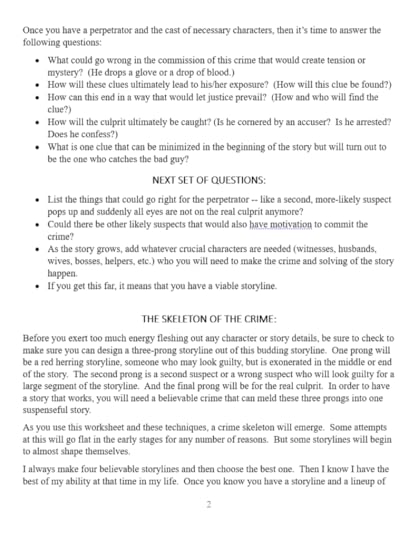 Once you have a perpetrator and the cast of necessary characters, then it’s time to answer the following questions:
Once you have a perpetrator and the cast of necessary characters, then it’s time to answer the following questions:
What could go wrong in the commission of this crime that would create tension or mystery? (He drops a glove or a drop of blood.)
How will these clues ultimately lead to his/her exposure? (How will this clue be found?)
How can this end in a way that would let justice prevail? (How and who will find the clue?)
How will the culprit ultimately be caught? (Is he cornered by an accuser? Is he arrested? Does he confess?)
What is one clue that can be minimized in the beginning of the story but will turn out to be the one who catches the bad guy?
NEXT SET OF QUESTIONS:
List the things that could go right for the perpetrator — like a second, more-likely suspect pops up and suddenly all eyes are not on the real culprit anymore?
Could there be other likely suspects that would also have motivation to commit the crime?
As the story grows, add whatever crucial characters are needed (witnesses, husbands, wives, bosses, helpers, etc.) who you will need to make the crime and solving of the story happen.
If you get this far, it means that you have a viable storyline.
THE SKELETON OF THE CRIME:
 Before you exert too much energy fleshing out any character or story details, be sure to check to make sure you can design a three-prong storyline out of this budding storyline. One prong will be a red herring storyline, someone who may look guilty, but is exonerated in the middle or end of the story. The second prong is a second suspect or a wrong suspect who will look guilty for a large segment of the storyline. And the final prong will be for the real culprit. In order to have a story that works, you will need a believable crime that can meld these three prongs into one suspenseful story.
Before you exert too much energy fleshing out any character or story details, be sure to check to make sure you can design a three-prong storyline out of this budding storyline. One prong will be a red herring storyline, someone who may look guilty, but is exonerated in the middle or end of the story. The second prong is a second suspect or a wrong suspect who will look guilty for a large segment of the storyline. And the final prong will be for the real culprit. In order to have a story that works, you will need a believable crime that can meld these three prongs into one suspenseful story.
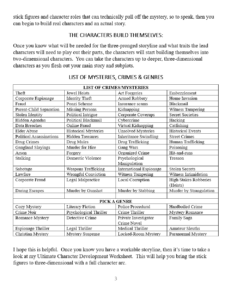 As you use this worksheet and these techniques, a crime skeleton will emerge. Some attempts at this will go flat in the early stages for any number of reasons. But some storylines will begin to almost shape themselves.
As you use this worksheet and these techniques, a crime skeleton will emerge. Some attempts at this will go flat in the early stages for any number of reasons. But some storylines will begin to almost shape themselves.
I always make four believable storylines and then choose the best one. Then I know I have the best of my ability at that time in my life. Once you know you have a storyline and a lineup of stick figures and character roles that can technically pull off the mystery, so to speak, then you can begin to build real characters and an actual story.
THE CHARACTERS BUILD THEMSELVES:
Once you know what will be needed for the three-pronged storyline and what traits the lead characters will need to play out their parts, the characters will start building themselves into two-dimensional characters. You can take the characters up to deeper, three-dimensional characters as you flesh out your main story and subplots.
LIST OF MYSTERIES, CRIMES & GENRES
LIST OF CRIMES/MYSTERIES
Theft
Jewel Heists
Art Forgeries
Embezzlement
Corporate Espionage
Identity Theft
Armed Robbery
Home Invasion
Fraud
Ponzi Scheme
Insurance scams
Blackmail
Parent-Child Separation
Missing Persons
Kidnapping
Witness Tampering
Stolen Identity
Political Intrigue
Corporate Coverups
Secret Societies
Hidden Agendas
Political Blackmail
Cybercrime
Hacking
Data Breaches
Online Fraud
Virtual Kidnapping
Catfishing
Elder Abuse
Historical Mysteries
Unsolved Mysteries
Historical Events
Political Assassinations
Hidden Treasures
Inheritance Swindling
Street Crimes
Drug Crimes
Drug Mules
Drug Trafficking
Human Trafficking
Gangland Slayings
Murder for Hire
Gang Wars
Poisoning
Arson
Forgery
Organized Crime
Hit-and-runs
Stalking
Domestic Violence
Psychological Manipulation
Treason
Sabotage
Weapons Trafficking
International Espionage
Stolen Secrets
Lawfare
Wrongful Conviction
Witness Tampering
Witness Intimidation
Corporate Fraud
Legal Malpractice
Local Corruption
High Stakes Robberies (Heists)
Daring Escapes
Murder by Gunshot
Murder by Stabbing
Murder by Strangulation
PICK A GENRE
Cozy Mystery
Literary Fiction
Police Procedural
Hardboiled Crime
Crime Noir
Psychological Thriller
Crime Thriller
Mystery Romance
Romance Mystery
Detective Crime
Private Investigator Crime Novel
Family Saga
Espionage Thriller
Legal Thriller
Medical Thriller
Amateur Sleuths
Christian Mystery
Mystery Suspense
Locked-Room Mystery
Paranormal Mystery
I hope this is helpful. Once you know you have a workable storyline, then it’s time to take a look at my Ultimate Character Development Worksheet. This will help you bring the stick figures to three-dimensional with a full character arc.
January 24, 2024
Character Development Worksheet
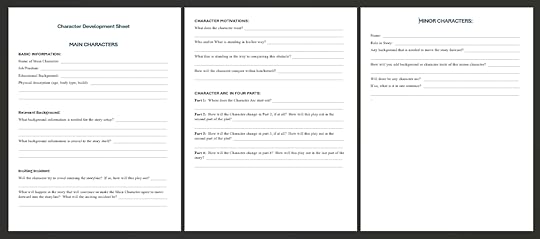
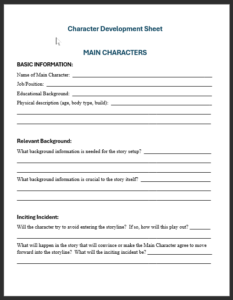 When I started writing several years ago, I came across the standard character worksheet and it focused mostly on physical attributes, occupation but there was a disconnect regarding their role in the storyline, which is the most important part.My purpose in this blog post is share a more in depth character development worksheet. I’ll go over the different parts of the worksheet with a brief explanation of the parts that need a little explanation. Most of the worksheet is self-explanatory.The first question is: Is this a Main Character you are developing? Or Minor Character? There is a separate Minor Character Development List on the third page of the checklist. We’ll begin with the Main Character development.The following aspects of the worksheet are self-explanatory. The only prompt I will give to beginning writers is that you want to keep your writing lean. So think in terms of what background, educational and job information is crucial for the plotline of the story? That’s the most important part.THE BASICS:Name of Main CharacterJob/PositionEducational BackgroundPhysical description – (age, body type, build)Relevant Background:What background information is needed for the story setup?What background information is crucial to the story itself?THE INCITING INCIDENT:Most plotlines need an inciting incident. This is the occurrence that happens to take the main character out of his/her normal life and into the storyline. What will this be?Sometimes it is an incident that happens but sometimes, like in a police procedural, it’s as simple as being assigned to a case. Either way, the inciting incident is what begins the actual story arc and the character arc.TWO MAIN QUESTIONS: Will the character try to avoid entering the storyline? If so, how will this play out?What will happen in the story that will convince or make the Character agree to move forward into the storyline? What will be the inciting incident?CHARACTER MOTIVATIONS:
When I started writing several years ago, I came across the standard character worksheet and it focused mostly on physical attributes, occupation but there was a disconnect regarding their role in the storyline, which is the most important part.My purpose in this blog post is share a more in depth character development worksheet. I’ll go over the different parts of the worksheet with a brief explanation of the parts that need a little explanation. Most of the worksheet is self-explanatory.The first question is: Is this a Main Character you are developing? Or Minor Character? There is a separate Minor Character Development List on the third page of the checklist. We’ll begin with the Main Character development.The following aspects of the worksheet are self-explanatory. The only prompt I will give to beginning writers is that you want to keep your writing lean. So think in terms of what background, educational and job information is crucial for the plotline of the story? That’s the most important part.THE BASICS:Name of Main CharacterJob/PositionEducational BackgroundPhysical description – (age, body type, build)Relevant Background:What background information is needed for the story setup?What background information is crucial to the story itself?THE INCITING INCIDENT:Most plotlines need an inciting incident. This is the occurrence that happens to take the main character out of his/her normal life and into the storyline. What will this be?Sometimes it is an incident that happens but sometimes, like in a police procedural, it’s as simple as being assigned to a case. Either way, the inciting incident is what begins the actual story arc and the character arc.TWO MAIN QUESTIONS: Will the character try to avoid entering the storyline? If so, how will this play out?What will happen in the story that will convince or make the Character agree to move forward into the storyline? What will be the inciting incident?CHARACTER MOTIVATIONS: As a newbie, it took me awhile to remember that a character needs to have an arc over the storyline. So it’s important — and time saving — to know what that arc will be before you even begin the draft. This character sheet can help you find this so you know where you are starting from and where you want to end up. The following questions should help you focus on what this character arc will be:
As a newbie, it took me awhile to remember that a character needs to have an arc over the storyline. So it’s important — and time saving — to know what that arc will be before you even begin the draft. This character sheet can help you find this so you know where you are starting from and where you want to end up. The following questions should help you focus on what this character arc will be:
I write in a four-part story line as opposed to the 3 part storyline. So I break the character arc into these specific parts:
Part 1: Where does the Character Arc start out?Part 2: How will the Character change in part 2, if at all? How will this play out in the second part of the plot?Part 3: How will the Character change in part 3, if at all? How will this play out in the second part of the plot?Part 4: How will the Character change in part 4? How will this play out in the last part of the story?MINOR CHARACTER: For minor characters, you only need to answer a few questions. It helps to know what role these minor characters will play and what, if any, background information is needed to support them in the storyline:
For minor characters, you only need to answer a few questions. It helps to know what role these minor characters will play and what, if any, background information is needed to support them in the storyline:
Click below
January 22, 2024
Book Review – My Swordhand is Singing
 Book Title: My Swordhand is Singing
Book Title: My Swordhand is Singing
Author: Marcus Sedgwick
AMAZON DESCRIPTION:
WHEN TOMAS AND HIS SON, Peter, settle in Chust as woodcutters, Tomas digs a channel of fast-flowing waters around their hut, so they have their own little island kingdom. Peter doesn’t understand why his father has done this, nor why his father carries a long, battered box, whose mysterious contents he is forbidden to know.But Tomas is a man with a past: a past that is tracking him with deadly intent, and when the dead of Chust begin to rise from their graves, both father and son must face a soulless enemy and a terrifying destiny.
WHY I CHOSE THIS BOOK: I’m always interested in why book reviewers choose the books they do, so I’ll reveal the reason behind my own choice. This book came up in a “Best Vampire Books” video I watched. I expected a “classic vampire book” as I started the book, but it wasn’t that at all.
MY REVIEW AS A READER: The story unfolded as more of a old-lore fairytale, a moral tale, that had a twist of vampire-like happenings in it. Vampires were barely mentioned by name. I like books that are written in a fairytale style so I kept reading. I especially like books that have some kind of moral ribbon running through it or at least a reference to a spiritual dimension. This book had all of the above.
I enjoyed the book and it was a fairly easy read. There was an unexplained box that was referenced and this held my interest and kept me reading. I won’t give anything away about the box, but it served as the ribbon of suspense that did run through the entire book.
It’s hard for me to comment on the writing as I’m still studying “fairytale writing” itself. The prose held the storybook style the entire way through so I give the author an A+ for that.
REVIEW AS AN AUTHOR: As I read, I paid particular attention to see how this fairytale style is done but I can’t yet put my finger on it. I did notice that the characters were only two-dimensional. They had their role to play in the plotline plus one thin layer of history that conjured up sympathy, compassion or empathy. I did notice that. There was distance between the reader and the soul of the character. I would love to discuss this with other authors, so if anyone else is interested in this style of writing, email me and let’s discuss it!
The author did a great job in recreating the lifestyle of woodcutters in the ancient world. The scenes were vivid and had a bit of a Charles Dickens feel to them. As an author, I think this is hard to do and I do take my hat off to Marcus Sedgwick for his writing style.
There was a band of gypsies in the story and their caravan and scenes were written very well. This too kept with the fairytale genre without seeming stereotypical. I can tell as an author that there was research done regarding “gypsies during ancient times”.
I plan to look through the book again and reanalyze some of the writing style to see what else I can learn about writing in the fairytale style.
THE BAD REVIEWS:
I always like to check author’s bad reviews after any book I read. I like to see if there there is any legitimate criticism. I find most bad reviews are just snotty comments made by readers in bad moods. But occasionally, I will find one with at least some critical value. The only 3-star review with a comment was that the reader was expecting a classic vampire story. I did have the same unmet expectation in this book. However, I was able to shift into this fairytale for what it had to offer.
I’ve also learned the hard way as an author myself that it’s important to let the readers know ahead of time what the book will be like because not everyone is okay to go into a book with one set of expectations and be able to shift into enjoying the book anyway. This 3-star review confirmed it. It seemed that the only reason for the lackluster review was this disappointment.
SOME TURN OF PHRASES I NOTED:
“She had eyebrows like a man’s that seemed fixed perpetually in a scowl.”“Do not trespass on my patience.”“She was still dressed in mourning weeds.”“The trunk where he’s been chopping gave a deafening crack, as if lightening had struck nearby.”
January 12, 2024
Advanced Reader Copy Checklist
Below are two screen shots of my checklist for organizing an Advanced Reader Copy Campaign.
I would only add one final suggestion — which I learned the hard way:
Be sure to put a disclaimer in the beginning of the book and right at the end if this is an advanced copy. I say this because if you offer the book early and then fix a few additional typos or anything else, the readers can forget that the book they just read was an advanced reader copy. Some readers can get a bit snotty in their reviews if they find these typos that get through! I think by having a little disclaimer that this is an early copy and not the final published copy, it may be a gentle reminder to the readers that whatever typos they saw were probably corrected in the final copy.
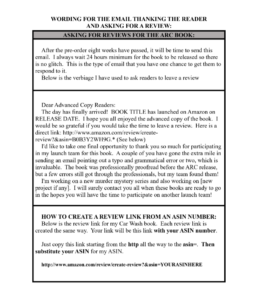
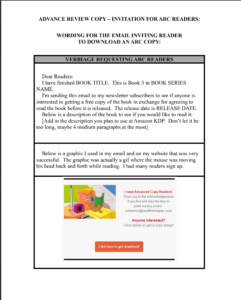
Sign up below to get the ARC Reader 2 Page Instructional:
January 9, 2024
Book Marketing – The Toolbox and File System
 Now that you have a generic marketing calendar, it’s time to assemble your toolbox. These are the things you will want to have close by when it’s time to dedicate an hour or two to marketing.GRAPHICS PROGRAM
Now that you have a generic marketing calendar, it’s time to assemble your toolbox. These are the things you will want to have close by when it’s time to dedicate an hour or two to marketing.GRAPHICS PROGRAM First into the toolbox is a graphics program. I used to use Photoshop, but since I retired from work, I now use Gimp because it’s free. I try to do everything as free as I can because I devote all monies spent on producing my books on an editor and paid book ads that work. I say ‘ads that work’ because many of them don’t. More on that in the next few blog posts.MARKETING CALENDAR:
First into the toolbox is a graphics program. I used to use Photoshop, but since I retired from work, I now use Gimp because it’s free. I try to do everything as free as I can because I devote all monies spent on producing my books on an editor and paid book ads that work. I say ‘ads that work’ because many of them don’t. More on that in the next few blog posts.MARKETING CALENDAR: I used to use Hootsuite, but it got too expensive and I couldn’t see enough in their desktop area. I switched to using a Microsoft Excel sheet. This allows me to continue to just Right-click and add a row above, so it is easy to build out the calendar. Within 6 months, I had about 4 to 6 daily marketing ads to post everyday. I find this the easiest.THE CRUCIAL BOOK INFORMATION:Below is a snapshot of the excel sheet as calendar I use. Below that is a list of everything else you will need to make any and all ads that come up. By having all of this at your fingertips, you can decide to dedicate one or two hours to marketing, and then be able to dive in without having to stop to fetch one thing after another.
I used to use Hootsuite, but it got too expensive and I couldn’t see enough in their desktop area. I switched to using a Microsoft Excel sheet. This allows me to continue to just Right-click and add a row above, so it is easy to build out the calendar. Within 6 months, I had about 4 to 6 daily marketing ads to post everyday. I find this the easiest.THE CRUCIAL BOOK INFORMATION:Below is a snapshot of the excel sheet as calendar I use. Below that is a list of everything else you will need to make any and all ads that come up. By having all of this at your fingertips, you can decide to dedicate one or two hours to marketing, and then be able to dive in without having to stop to fetch one thing after another.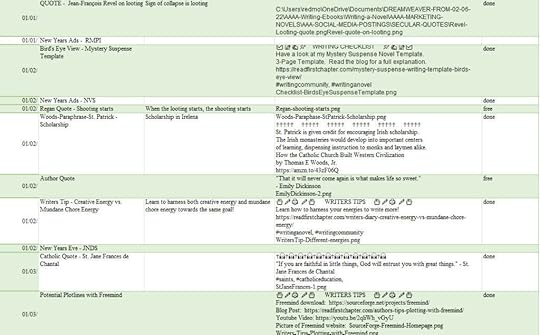 I like using the Excel sheet because I can see a bird’s eye view of what’s coming up over the next few days or weeks. I can also use the scroll bar to zip around and see what else is coming up. I can use the find feature — Control F — to find anything by using a keyword or two. And last but not least, I can copy emojis and they paste out in the color onto social media! I’ll post one below. All I do is copy and paste this from the excel sheet:
I like using the Excel sheet because I can see a bird’s eye view of what’s coming up over the next few days or weeks. I can also use the scroll bar to zip around and see what else is coming up. I can use the find feature — Control F — to find anything by using a keyword or two. And last but not least, I can copy emojis and they paste out in the color onto social media! I’ll post one below. All I do is copy and paste this from the excel sheet:




 BOOK MARKETING
BOOK MARKETING 




Where and How does Book Marketing Start?
First you need a generic marketing calendar to user year after year
Learn More
 https://readfirstchapter.com/book-mar...
https://readfirstchapter.com/book-mar...#bookmarketing, #selfpublishing, #marketingadsA BOOK COVER IN THE RIGHT RESOLUTION:You will need a digital book cover in 72 dpi size format. This is smaller than the size needed for a printer. If your book cover pictures are too big, then you can shrink them down using Gimp. I’m making a mental note to do a short video on how to do that.MAKE A CHEAT SHEET OF INFORMATIONNext you want to make a cheat sheet by gathering all of the following information in one document so you can copy and paste it easily. I use a Notepad document because they are easy to open, can stay up when other programs are open, and they have the “find feature” as well.
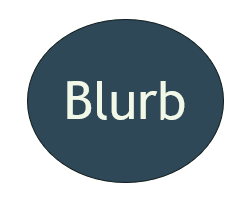 Along with the 72 dpi book cover, you will need short blurbs about your book or books. Starting at about 150 words, keep whittling the blurb down until you have several blurbs with the last one being about one sentence (for Amazon ads).The quickest way I have found to do this shrinking blurb routine is to start with the blurb from the back of the paperback. I copy and paste that into my cheat sheet. Then I whittle that one down by 20 to 30 words and save that one too. Somewhere after 75 words, you’re down to just what I would call ‘an ad blurb’. I do this whittling down using a Word document, so I can record how many words the blurb is. I keep that with each blurb.
Along with the 72 dpi book cover, you will need short blurbs about your book or books. Starting at about 150 words, keep whittling the blurb down until you have several blurbs with the last one being about one sentence (for Amazon ads).The quickest way I have found to do this shrinking blurb routine is to start with the blurb from the back of the paperback. I copy and paste that into my cheat sheet. Then I whittle that one down by 20 to 30 words and save that one too. Somewhere after 75 words, you’re down to just what I would call ‘an ad blurb’. I do this whittling down using a Word document, so I can record how many words the blurb is. I keep that with each blurb. Copy and paste any and all purchase links for your book. Be sure to keep track of which merchant each link belongs to. Besides the purchase links, you may want to keep the paperback and hardcover links handy — you never know!If you have a sample of the book posted online, be sure to record this link as well. Using free giveaways of the first few chapters is a good sales pitch. Record any Bookfunnel and Site Origin book links. Anytime you can use the giveaway links, it’s another opportunity to build your reader list, also known as a mailing list or a newsletter list.HASHTAGS:
Copy and paste any and all purchase links for your book. Be sure to keep track of which merchant each link belongs to. Besides the purchase links, you may want to keep the paperback and hardcover links handy — you never know!If you have a sample of the book posted online, be sure to record this link as well. Using free giveaways of the first few chapters is a good sales pitch. Record any Bookfunnel and Site Origin book links. Anytime you can use the giveaway links, it’s another opportunity to build your reader list, also known as a mailing list or a newsletter list.HASHTAGS: Most younger people know what hashtags are. If you’re a boomer like me (hee hee), you may need to brush up on what hashtags are. Go to YouTube and search out videos explaining hashtags. Someone will explain them to you.For others who know what they are but don’t know how to use them, I’ll give you the first few to get you started.#readersoffacebook
Most younger people know what hashtags are. If you’re a boomer like me (hee hee), you may need to brush up on what hashtags are. Go to YouTube and search out videos explaining hashtags. Someone will explain them to you.For others who know what they are but don’t know how to use them, I’ll give you the first few to get you started.#readersoffacebook#readersofinstagram
#readersoftiktok
#bookstagram
#booktokROYALTY FREE IMAGES:For any advertising, you will need royalty free images and graphics. I use DepositPhotos.com . There is another place called pixabay.com and they offer totally free pictures and graphics. You may want to start with them.Did you know that if you are a Microsoft 365 customer, there are thousands of pictures, illustrations, icons and more available to you in the Powerpoint program? I’ve started using those as a new resource for free photos.Anyway, you will need to have royalty free images to use in marketing.PICTURE AND ADS FILING SYSTEM:

For the first year, I had pictures and ads all over the place. This year I sat down and devoted about two hours to organizing all of my various pictures on my computer. Everyone has their own filing systems and I’m not claiming mine is the best, but for anyone who wouldn’t know where to begin, this can get you started.
I use one file called “Royalty Free Photos” where I keep all the photos I download from Deposit Photos, Pixabay or even Powerpoint. I use a naming style shown below so I know where I got the picture:DP-Picture-Description.png ==> DepositPhotos.GI-Picture-Description.png ==> Google imagesPX-Picture-Description.jpg ==> Pixabay picturePPT-Picture-Description.png == Powerpoint pictureI keep my marketing ads that I make in a large folder called “MarketingImages”. I keep pictures of the ads and my 72dpi book covers in this file. I use a naming taxonomy as follows:
RMPI-Ad-Description.png ==> Ryan Mallardi Private InvestigationsNVS-Ad Description.jpg==> Newport Vampire Stories SeriesJNDS-Ad Description.png==>Jack Nolan Detective SeriesGroomed-Ad-Description.png ==> Ad about Groomed for MarriageSanctuary-Ad-Description.png==> Ad about Murder in the SanctuaryI keep all of these pictures and graphics in the Marketing Images folder. I allow them to all swim free in the one folder. It seems chaotic, but I can use the find feature to fetch anything I need. When I want to find a picture of the ads I’ve made for a series of books, then I click “Control F” and type in “RMPI” and all of the ads that I have with that naming nomenclature come up. Then I can pick one. There is nothing more frustrating than having to enter and exit subfolders!I hope you enjoyed this segment of my Book Marketing for Authors series. Be sure to see my YouTube Channel for more marketing videos.Next I am planning on demonstrating how to make the first ad that you will need, the book cover and summary like the one i have below: Next Blog Posts: The first ads – All About the Book
Next Blog Posts: The first ads – All About the Book
Book Marketing for New Authors
 Book Marketing is a huge undertaking, but it starts with baby steps. When I was brand new, the mere subject of book marketing was enough to make me feel completely overwhelmed. However, now looking back, I see that it started with baby steps and book marketing isn't something you do, it's something you build.
Book Marketing is a huge undertaking, but it starts with baby steps. When I was brand new, the mere subject of book marketing was enough to make me feel completely overwhelmed. However, now looking back, I see that it started with baby steps and book marketing isn't something you do, it's something you build.
Every book marketing video I watched would exhaust me just thinking of how much more I was expected to do to market my books. I'm writing this blog post to offer the most important tips I would give to myself as a new author and an other new authors and book marketers.
 This first installment is to set the framework of your marketing plan. The calendar list below is meant to be sort of a file box. Think of each holiday as a marketing opportunity. You will build your marketing plan by starting with this calendar.
This first installment is to set the framework of your marketing plan. The calendar list below is meant to be sort of a file box. Think of each holiday as a marketing opportunity. You will build your marketing plan by starting with this calendar.
When you make Christmas or Halloween ads for your books, they will go in your file and next year, you will have two ads instead of one. Make all of your marketing ads generic so they can be used over and over again. This is one way to build your arsenal of marketing.
ORGANIZE EVEN THE FIRST MARKETING EFFORTS!
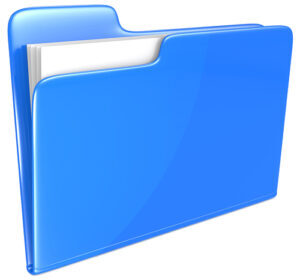
I'm not an expert on marketing, but have learned quite a bit in the last three to four years. One problem I had in the beginning is I would be caught short -- not prepared for all the different marketing opportunities. I was focused on marketing platforms, but I never far enough ahead and prepared for the various marketing seasons.
Below is a Generic Holiday Marketing Calendar that I now use to 'think ahead'. It's January 9th as I write this, and I'm thinking about Valentine's Day and how I will take advantage of that holiday to market my books.
January
New Year’s Eve – December 31stNew Years DayJanuary 7th – Little Christmas (Magi reached Jesus)Martin Luther King Day – 3rd Monday in JanuaryFebruary
Valentine’s Day – February 14thWashington’s Birthday – 3rd Monday in FebruaryMarch
International Woman’s Day – March 8thPatrick’s Day – March 17th1st Day of Spring March 19th or 20thEaster – Date varies in March or April with moonApril
April Fool’s Day – April 1Earth Day – April 22ndMay
Mother’s Day – 2nd Sunday in MayMemorial Day – Last Monday in MayJune
Father’s Day – 3rd Sunday in JuneFirst Day of Summer – June 20th or 21stJuly
Independence Day – July 4thPrime Day – 2 Days – mid July – dates varyAugust
The Dog Days of August – the entire month is applicableSeptember
Grandparent’s Day – 1st Sunday in SeptemberLabor day – 1st Monday in SeptemberNational Hispanic Month – Starts September 15th1st Day of Autumn – September 22 or 23October
Prime Early Access Sale: October 10-11 – dates varyColumbus Day – 1st MondayHalloween – October 31stNovember
Thanksgiving Day – 4th Thursday in NovemberBlack Friday – Day after ThanksgivingCyber Monday – Monday after ThanksgivingAmazon Prime Day – 2 Day holiday – date variesDecember
First Day of Winter – December 21stChristmas Eve – December 24thChristmas Day – December 25th MARKETING ADS AND BOOK COVERS: Earlier this year I started uploading YouTube videos targeting beginner writers and marketers who want to learn how to make their own book covers. Gimp is a free photo manipulation program -- completely free. Volunteer coders from around the world, unsung heroes, have worked on this computer program for the masses.
Earlier this year I started uploading YouTube videos targeting beginner writers and marketers who want to learn how to make their own book covers. Gimp is a free photo manipulation program -- completely free. Volunteer coders from around the world, unsung heroes, have worked on this computer program for the masses.
Many authors are on a tight budget, especially when there are many businesses that have set up around self-publishing authors who are only too happy to take money. That's why it's so important to plan where you will spend your money in publishing and marketing books.
The Gimp program is a Photoshop knock-off, so to speak, but an author only needs to learn how to operate about 8 of the tools in the program in order to create marketing ads and book covers. This is a way to save money. So be sure to check out my YouTube Playlist here.
If you would like to download this generic Book Marketing List, sign up below.
WHAT COMES NEXT? Now that we have gone over the list of marketing events that will be the framework of our marketing plan, it's time to focus on the marketing toolkit next.
Now that we have gone over the list of marketing events that will be the framework of our marketing plan, it's time to focus on the marketing toolkit next.
What will you need to keep handy and in one place in order to master a growable marketing plan? What will be in that toolbox?
In the meantime, you may want to watch a short video or two where I explain how I go about making two or three holiday ads for my books.
January 7, 2024
Novel Scene Improvement Checklist
 This is a checklist I wish I had when I first started out as an author. With the internet and research being at our fingertips, anyone can figure out how to write a first draft. In the world I live in, a first draft is nothing more than blurting out the story onto paper so you have something to begin working on.
This is a checklist I wish I had when I first started out as an author. With the internet and research being at our fingertips, anyone can figure out how to write a first draft. In the world I live in, a first draft is nothing more than blurting out the story onto paper so you have something to begin working on.
When writing the first draft, you don't even have on your author's hat yet. You are only a mapmaker really. You are putting down the basic storyline that can be massaged into a real story and ultimately into a real novel.
In my opinion, we are all limited by our capabilities as they exist in time. That means that you can only write the story to the best of your ability, based on what you presently know.
The purpose of this blogpost and checklist is to go over techniques that will allow you to expand your horizons. Let it guide your creative mind in certain areas with the intent purpose of "taking the story up a notch". These questions helped me along the way, but like I said earlier, I wish I began to ask them earlier in my author journey.
I offer them now to new authors in the hopes that this will help you take new ground as an author and improve your scenes beyond what you may be capable of at any given time.
ESTABLISH WHERE YOU ARE This questionnaire is meant to be applied after you have written a first draft and have gone over the draft once in order to make sure the story flows from scene to scene and from chapter to chapter.
This questionnaire is meant to be applied after you have written a first draft and have gone over the draft once in order to make sure the story flows from scene to scene and from chapter to chapter.
A Special Note to Beginners: Any attempt to "write perfectly" with these questions in mind will only slow down your draft process. I have other beginner advice in my Peek Behind the Novel series you may be interested in.
This checklist is meant to be applied to each scene individually during the massaging stage. What is the massaging stage? Each new novel begins with a draft stage, goes into an overall check for the flow of the story and then to a single focus of making sure all clues and twists are all in their proper place. Then you enter the massaging-the-story stage. This is where this checklist will be very helpful.
QUESTIONS TO ASK ABOUT EACH SCENE:Whose point of view is the scene being written in? Where is the location of the scene? Is there an outer location and an inner location? For example: Is there a cabin that is located a long drive away? This may require two location descriptions.What is the purpose of the scene?Is the main character “arcing” in the scene? Is there something that is changing about him or her? How is this being shown (not told)?What is the high point of the scene? Where would there need to be a “close-up”?Is there at least a ribbon of suspense still running through the scene?What clues have been dropped in the scene?QUESTIONS FOR EACH INDIVIDUAL SCENE By focusing on each element individually with these questions in mind, it will allow a new author to focus on only one element at a time. It prevents new authors from becoming overwhelmed by a general suggestion to take the whole novel up a notch.
By focusing on each element individually with these questions in mind, it will allow a new author to focus on only one element at a time. It prevents new authors from becoming overwhelmed by a general suggestion to take the whole novel up a notch.
In my opinion, by focusing on each scene individually, you will erase any rushing that may have occurred in the draft process. It will give you a second chance to see if you can better describe something or foreshadow something early on in the plot.
Below are the questions that are designed to refocus a new author to how and where each scene can be improved.
HOW CAN YOU TAKE THE SCENE UP A NOTCH?
Make sure all viewpoints, feelings and thoughts are attached to the person who owns the point of view of the scene. Using vivid memories or pictures, how can you describe the location or two locations of the scene in a way to add information that brings depth to the storyline? Is there a way to use this subtlety to foreshadow something? How can you add atmosphere and/or impending doom and/or rising stakes into your location descriptions?Check to make sure the purpose of the scene is clear for the reader who is reading the story for the first time. Remove anything that’s boring or unnecessary. If something doesn’t serve the story, it should be removed.Can you add a bit of drama to the high point of the scene without being melodramatic? Identify the way in which your ribbon of suspense is lacing through the scene. Do you have a statement, an event, a feeling, something that holds up the suspense in the scene?Are the clues dropped in such a way that they are actual data points that the reader will recognize and use to try to figure out what is going on?ADVANCED TECHNIQUES ADVANCED TECHNIQUES: TAKE THE SCENE TO THE TOP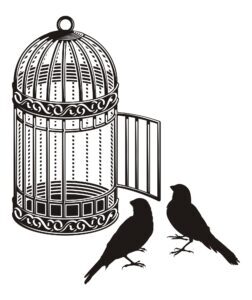 Metallic bird cage with open door and two bird silhouettes.
Metallic bird cage with open door and two bird silhouettes.The following writing techniques may be hard for new authors. They are still hard for me after 12 novels. But they are good suggestions to keep in mind as you get more experience as an author.
These questions can be used over and over and you will see your writing take new ground with each scene as you push yourself to one tiny improvement at a time.
Can you add a hook into the beginning of the scene? Will something happen that will make the reader want to keep reading? Is there something that will invite readers to feel they are going deeper? Can you add a surprise, a shock, or a twist at the end of each chapter? Having a tiny cliffhanger or surprise or shock at the end of the scenes is a way to add to the overall suspense of the book – and keep the readers reading. Can you add a motif of some kind? For example: In the Harry Potter books, Good vs. Evil was a classic motif that ran throughout the story. The red rose in The Great Gatsby signifies Gatsby's love and longing for Daisy. In my opinion, these two are advanced techniques that will come with experience. This is another reason to not spend too much time fussing about anything in the first draft. The first draft is only a starting point, words on paper. It’s where the art of writing begins.If you would like to download the above-checklist in pdf format, see the sign up below. I promise I won't spam you.
January 5, 2024
Book Review – Frankenstein
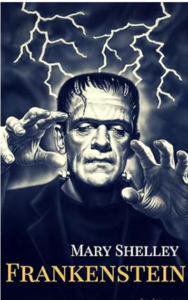 Book Title: Frankenstein
Book Title: FrankensteinAuthor: Mary ShellyDescription from Amazon.com:
Frankenstein; or, The Modern Prometheus, generally known as Frankenstein, is a novel written by the British author Mary Shelley. The title of the novel refers to a scientist, Victor Frankenstein, who learns how to create life and creates a being in the likeness of man, but larger than average and more powerful. In popular culture, people have tended to refer to the Creature as “Frankenstein”, despite this being the name of the scientist. Frankenstein is a novel infused with some elements of the Gothic novel and the Romantic movement. It was also a warning against the “over-reaching” of modern man and the Industrial Revolution, alluded to in the novel’s subtitle, The Modern Prometheus. The story has had an influence across literature and popular culture and spawned a complete genre of horror stories and films. It is arguably considered the first fully realized science fiction novel.
REVIEW AS A READER:It was hard to separate the reader and the author in this read because I chose this book to do a gothic study. I saw a video by Tristan and the Classics from YouTube where he suggested reading the top 5 to 10 books in the gothic genre to get a sense of not only what the genre contains, but also how one book led to the other historically. I did just that and Frankenstein was one of the suggested books.
Like many people, I assumed the book was about a monster named Frankenstein. Not so. The scientist’s name is Frankenstein and the monster is his creation.
Knowing that Mary Shelly was only 18 or 20 years old when she wrote this story was shocking to me because the book deals with a deep subject for the times in which she lived. Science had been delving into the issue of where does medicine stop and meddling in God’s handiwork begin. There is always a certain amount of fear associated with new scientific discovery. In our day there are those who fear that AI will take over the world. This book was written in the face of some scientific fear that was prevalent in her day.
The book opens with a series of letters that anchor the reader into the time and place this story will unfold. Dr. Frankenstein is fascinated by all things scientific. His family sees that he has talent in this area and they insist he get extended education and experience, which he does.
At first Dr. Frankenstein is motivated by the ability to help people, to affect a positive change in the world. But slowly, this motivate gets twisted into a hunger for the fame and acclaim he will get for being able to rid humanity of illness. In this state of mind, he meats another scientist of his day, who shows him the ropes, so to speak, about doing scientific exploration. It sounded from the book that this type of cutting edge scientific exploration was done in the proverbial “garage labs” — sort of like where Bill Gates and Steve Jobs started out.
I won’t give away any of the details of what happens from this point forward because this is the story. Everyone knows, of course, that he creates this monster that is known world wide by the name of Frankenstein. But there is much more to the story than that.
As a reader, I had the usual struggle of reading “British” idioms and colloquialisms. I get the feeling that I’m missing something at times when I’m reading English writers. There was also the tiny struggle associated with reading a book that was written so long ago. The language changes and it’s easy to miss things. I kept with it. With my Kindle highlighter, I kept track of all the characters and the plot points.
I would say this was a moral gothic tale about mankind overstepping our bounds scientifically. It was also a moral story about how the absence of virtue and living a life based on revenge can destroy people.
I enjoyed the book and did learn a lot about the gothic genre from it. Frankenstein by Mary Shelley was one of the first gothic books, one of the books that launched the gothic genre.
REVIEW BY AUTHOR:Structurally, the book opened with a series of letters back and forth between I believe Dr. Frankenstein and his sister. I say “I believe” because I find myself not always “sure” of things when it’s a British writer. I don’t know if I’m alone in this, but in any event, the series of letters was a vehicle of dropping information about the backdrop of the story.
I have seen this method used many, many times in books today and always notice what the purpose of the letter-structure is. It added a bit of interest and intrigue into layout out the backdrop of the drama that was about to unfold.
The next part of the book reveals Dr. Frankenstein as quite a young man. He is filled with excitement and an unquenchable thirst for scientific knowledge. As stated earlier, he had all the best intentions in the beginning, but somewhere during his “forming” as a scientist, his ego took over and he stepped over the line. He develops the ability to give life to the lifeless and decides to create a man — I mean, why not? Well, it doesn’t go exactly as expected.
The main story is about how this experiment affected the creature as well as Dr. Frankenstein. The doctor’s knowledge stopped at how to create a creature, but he didn’t know how to care for and love a creature.
From a Christian perspective, his ego led him down the path of arrogance. He is overconfident and this blinds him to the fact that he has now crossed the line into “God’s domain”, the creation of life. As just stated, although he was able to give life to this creature, he wasn’t able to care for him or provide a world where anyone could care for him. It shows the limitations of mankind and the disaster that occurs when arrogant men play God.
The story is about what happens to Dr. Frankenstein, his family and the creature. It is also a statement, although very subtle, of how the absence of virtue mixed with an obsession for vengeance can destroy a person’s life, even their family’s lives.
Again, as an author, I couldn’t help but be so impressed with what young Mary Shelly was capable of not only understanding but her ability to craft a story around some very difficult issues.
It is a must read for anyone interested in the gothic genre. I would highly recommend it.
SOME MEMORABLE QUOTES FROM THE PATIENT:“. . . but it is the custom of the Irish to hate villains”“I pursued him, and for many months this has been my task. Guided by a slight clue, I followed the windings of the Rhone, but vainly . . .”“She was a hired nurse, the wife of one of the turnkeys, and her countenance expressed all those bad qualities which often characterize that class.”MY FAVORITE TURN OF PHRASES:She perished on the scaffold as a murderess.. . . sudden turn of a promontory, flourishing vineyards with green sloping banks and a meandering river and populous towns occupy the scene.The soil was barren scarcely affording pasture for a few miserable cows and oatmeal for its inhabitants, which consisted of five persons, whose gaunt and scaggy limbs gave tokens of their miserable fare.. . . hardly conscious of its extreme profundity until my ear was arrested by the paddling of oars near the shore . . .A few fishing vessels alone specked the waterthe gentle breeze wafted the sound of voices as the fisherman called to one another.. . . astonishment was exhibited in my countenance,. . . languishing in death, the dark orbs nearly covered by the lids and the long black lashes that fringed them;He wished me to seek amusement in society. I abhorred the face of man.The murderous mark of the fiend’s grasp was on her neck . . .wandering ministers of vengeanceI now related my history briefly but with firmness and precision, marking the dates with accuracy and never deviating into invective or exclamation.Everything was silent except the leaves of the trees, which were gently agitated by the wind; the night was nearly dark, and the scene would have been solemn and affecting even to an uninterested observer.He had heard my story with that half kind of belief that is given to a tale of spirits and supernatural events;December 29, 2023
Mystery Suspense Writing Template – Birds Eye View
 BIRDS EYE STRUCTURE CHECKLIST FOR A MYSTERY NOVEL
BIRDS EYE STRUCTURE CHECKLIST FOR A MYSTERY NOVEL 
FOUR ACT NOVEL STRUCTURE – PART 1
THE HOOKHow can you immediately hook the reader’s interest?
INTRODUCTIONIntroduction of the Main Character (MC)
INCITING INCIDENTWhat happens to draw a reluctant MC into the story or plot?
FOUR ACT NOVEL STRUCTURE – PART 2
THE PLOT THICKENSWhat happens early in part two that deepens the plot?
HOW DOES THE MC CHANGE?What happens in the story that begins to change the MC?
MIDPOINT OF STORYWhat Twist or Surprise will take place by the middle of the story?
FOUR ACT NOVEL STRUCTURE – PART 3
SURPRISES REVEALED Surprising Clues or Revelations of hidden truths or lies. This reveals ¾ of the truth of the plot.FULL TRUTH REVEALWhat is the final clue that reveals the entire truth? How does this new info change the plotline or turn it in another direction?
POSITIONING FOR THE CLIMAXWhat is the final setup needed for the climax or big reveal to occur?
FOUR ACT NOVEL STRUCTURE – PART 4
CLIMAX SCENEFull Truth or Revelation made. What emotions need to be displayed?
QUICK REVIEWReview of the plot quickly and indicate how the MC solved the mystery
THE NEW NORMALHow is the MC different going forward? What does the new normal look like?
THE HOOK: What can happen on the first page or two that will draw the reader immediately into the story? What questions will arise to make the reader want to keep reading to find out?
MAIN CHARACTER: The readers want to know who the story is about as well as who is telling the story. What will make the MC compelling enough that the readers will want to know more about them and keep reading?
INCITING INCIDENT: How or Why does the reluctant MC get involved in the story/journey? What clues can you introduce early on regarding why the MC chooses to get involved? (The clues in the beginning are aiming at a red herring or a first dead-end. Remember, early on, you are holding back a lot of truth about where you and the reader are actually going. 
THE PLOT THICKENS: How does the plot deepen in part two? What background information, clues, facts or lies are dropped to relay the story and add to the suspense or mystery of the story pathway going forward?
MAIN CHARACTER ARC: Think ahead of time where the MC will begin in his/her character arc. Then think of ways to show the full arc and how you will add these changes into the plot. How will this play out in action? How does he or she change as the result of what is going on in the plot? How will lies or surprises or shocks affect your MC?
FIRST TWIST OR SURPRISE: What surprise, turn or twist can take place at the end of part 2? This is where your story will proceed to the second arm of the cactus. How will this surprise change the pathway of the novel’s journey? What shifts with this turn?
SURPRISES REVEALED: What surprise will be revealed in this section? How will this change the direction of the plotline? What change or changes can happen in this section to set up the ultimate revelation of the plotline? In mystery suspense novels, only ¾ of the truth of the plot is revealed in the beginning of Part 3. You’re still in the second arm of the cactus.
FINAL TRUTH REVEALED: In mystery suspense, it’s good to have a final revelation or clue drop to give a final twist to the plotline. This will bring you and the reader onto the main plotline that will lead to the climax and the truth. What can this be?
POSITIONING FOR THE CLIMAX: Position the characters and make all revelations by the end of Part 3. The Climax should be set up by this time.
CLIMAX SCENE: How will the climax play out? What action will there be? What emotions will take place? How will the location of the scene help this?
QUICK REVIEW: Some readers are busy and may miss a clue or two. Other readers will be on your every word. How can you review the facts in a way that will fill in the gaps for the busy readers and not bore the seasoned mystery readers? You need a way to go over the plotline quickly without insulting the avid readers.
THE NEW NORMAL: This is the scene that allows the reader to breathe, lets them know all is well and life will go on. You want to give the reader a view of how the new normal will be, how the MC will be different going forward. How has the past drama or story changed the MC and how will he or she be different?
This can also be a scene where you are setting up the next book in a series. If you do, be aware, many readers don’t like cliffhangers, so be careful.
Click below to download the template:
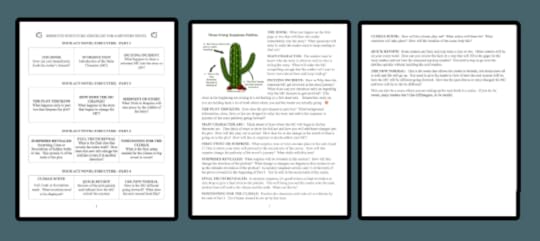
December 27, 2023
Book Review – The Patient
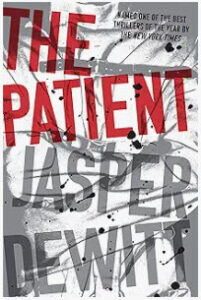 Book Title: The Patient
Book Title: The PatientAuthor: Jasper DeWittDescription from Amazon.com:
The Silent Patient by way of Stephen King: Parker, a young, overconfident psychiatrist new to his job at a mental asylum miscalculates catastrophically when he undertakes curing a mysterious and profoundly dangerous patient.
In a series of online posts, Parker H., a young psychiatrist, chronicles the harrowing account of his time working at a dreary mental hospital in New England. Through this internet message board, Parker hopes to communicate with the world his effort to cure one bewildering patient.We learn, as Parker did on his first day at the hospital, of the facility’s most difficult, profoundly dangerous case—a forty-year-old man who was originally admitted to the hospital at age six. This patient has no known diagnosis. His symptoms seem to evolve over time. Every person who has attempted to treat him has been driven to madness or suicide.
Desperate and fearful, the hospital’s directors keep him strictly confined and allow minimal contact with staff for their own safety, convinced that releasing him would unleash catastrophe upon the outside world. Parker, brilliant and overconfident, takes it upon himself to discover what ails this patient and finally cure him. But from his first encounter with the mysterious patient, things spiral out of control and, facing a possibility beyond his wildest imaginings, Parker is forced to question everything he thought he knew.
Fans of Sarah Pinborough’s Behind Her Eyes and Paul Tremblay’s The Cabin at the End of the World will be riveted by Jasper DeWitt’s astonishing debut.
REVIEW AS A READER:I researched “best psychological thrillers” on Bard.google.com and this book, The Patient, came up as number one. I read through the Amazon description, but I chose it based on Bard’s recommendation.
The psychological mystery and drama started from the first page. The mystery was subtle at first, but it was definitely there. I was hooked and wanted to know more from the first page. The story unfolded slowly but it was never boring.
Reading the book was like driving on long winding roads, not knowing the ultimate destination, and also not being sure what lay right around the bend. The drama moved along without stop. The story never sagged or drove off onto some boring side road. The mystery and suspense were constant.
There was an intimacy in the story as some of it was written in first person. Other parts were written in third person where the story took on more of a bird’s eye view and a bit of narration. It all worked and added to the mystique of the book.
I did feel that at the end of the book, the ending veered off into a bit of unexpected sci-fi or fantasy I was not expecting, but it was still an enjoyable book from start to finish.
REVIEW BY AUTHOR:The book was written well, and I highlighted several phrases that were memorable. I have them listed below. I learned a lot about presenting a psychological drama for the reader and how to subtly suggest that there was something “off” about people, places and/or things.
I learned about weaving the psychological plotline into the mystery itself as I did notice that there needed to be a timeline that coincided with someone’s hospitalization. I always thought of psychological suspense stories as one kind of book, but I learned from reading The Patient that a crime/mystery timeline supported the story and the psychological elements weaved all throughout this spinal timeline. I found this very helpful as an author myself.
I also learned about how “withholding information from the reader” worked in a psychological mystery. I always feel obligated to reveal everything to the reader, but this is not necessary. Withholding some parts of the truth add to the ultimate surprise and satisfaction of the reader. It’s not dishonesty, but rather more of a slight of hand for the benefit of the story.
This story was very original. It didn’t read like a remake of some other popular novel — at least I didn’t see anything like that. The originality of the storyline, as well as the unwrapping of the greater mystery, held my interest the entire way, to the last page.
I would recommend this book to any reader of psychological mysteries. I would even recommend this to medical mystery readers.
SOME MEMORABLE QUOTES FROM THE PATIENT:“. . . her voice carrying a faint lilt that I recognized as Irish,”“So forcing my frustration down to a simmer, I gave him the most deferential nod I could manage. It seemed to appease him.”“This was the sort of place where pain of any kind was either flushed out with medication and trips to boutique psychiatrists or kept at a respectable distance with copious expenditures. It was, in short, a place where anything unpleasant, let alone a supernatural horror, had been ruthlessly gentrified out of sight and out of mind.”“He spun around with military precision . . .”“She had a kindness to her, but it was girded with such naturally aristocratic steel that I imagined she’s been born ringing a bell to summon servants.”



